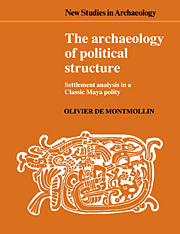Book contents
- Frontmatter
- Contents
- List of figures
- List of tables
- Preface
- 1 Studying ancient complex polities
- 2 Thinking about Maya political structure
- 3 The Rosario polity
- 4 Linking Maya politics and settlement
- 5 Centralization
- 6 Differentiation and integration
- 7 Political regimes and microcosms
- 8 Political stratification patterns
- 9 Mechanical versus organic solidarity
- 10 Segmenting versus non-segmenting organization
- 11 Archaeological study of Maya polities
- Notes
- References
- Index
11 - Archaeological study of Maya polities
Published online by Cambridge University Press: 29 March 2010
- Frontmatter
- Contents
- List of figures
- List of tables
- Preface
- 1 Studying ancient complex polities
- 2 Thinking about Maya political structure
- 3 The Rosario polity
- 4 Linking Maya politics and settlement
- 5 Centralization
- 6 Differentiation and integration
- 7 Political regimes and microcosms
- 8 Political stratification patterns
- 9 Mechanical versus organic solidarity
- 10 Segmenting versus non-segmenting organization
- 11 Archaeological study of Maya polities
- Notes
- References
- Index
Summary
Conceptualizing an ancient polity
I selected bundled continua of variation in place of societal typologies in order to conceptualize the Rosario polity as an example of an ancient complex polity. Why was this? By so doing, some difficulties associated with societal typologies could be avoided. The full range of these difficulties concerned: resistance of whole societies (or polities) to typological analysis; difficulties of choosing scale and locating boundaries for societal types; undue reification of society; undue reification of societal types; inappropriately categorical thinking (for the study of continuous variation); inability to account for change from one type to another; a priori technoenvironmental determinism (entailed by using a typological approach for societies but not for their physical environments); real rather than nominal definitions (Service 1985) for types, with assumed co-variation of several attribute levels and elimination of worthwhile research problems; and, finally, dubious extrapolation from documented attribute levels to undocumented attribute levels (Chapter 2).
The bundled continua approach derives from work done in political anthropology. The central premise is that it is “useful to place phenomena on a continuum, with the expectation that to do so will make it possible to locate cluster points” along several of the aligned continua (Easton 1959: 239). Reasons for the recurring clusters may then be sought. With such an approach, awkwardly multivariate societal types are broken down into more easily studied constituent variables. The existence of continuous as well as discontinuous variation is allowed for by avoiding a priori polar-categorical thinking. The object of study is given a nominal rather than a real definition (Service 1985), thus avoiding an essentialist approach which seeks to identify and discuss the true aspects of phenomena.
- Type
- Chapter
- Information
- The Archaeology of Political StructureSettlement Analysis in a Classic Maya Polity, pp. 217 - 253Publisher: Cambridge University PressPrint publication year: 1989

